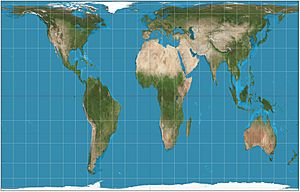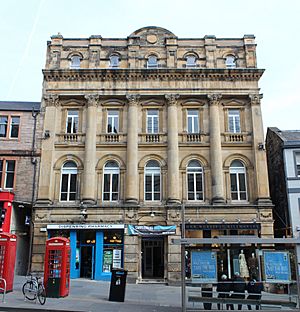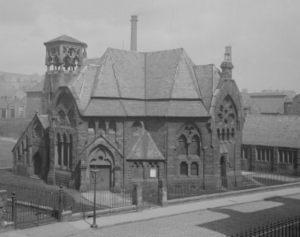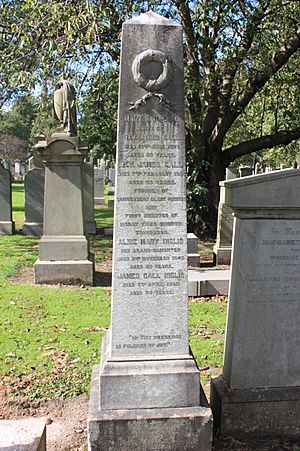James Gall facts for kids
James Gall (born September 27, 1808 – died February 7, 1895) was a Scottish minister. He started the Carrubbers Close Mission in Edinburgh. James Gall was also very talented in many areas. He was a mapmaker, a publisher, a sculptor, an astronomer, and a writer. In mapmaking, three different map styles are named after him. These are the Gall stereographic, Gall isographic, and Gall orthographic (also known as Gall–Peters projection).
Contents
Early Life and Education
James Gall was born in Edinburgh, Scotland, on September 27, 1808. His parents were Ann Collie and James Gall. His father was a printer who started a company called Gall & Inglis. This company was known for making astronomy books that were easy to understand.
James went to the High School near his home. He also studied at the Trustees Academy. From 1822, he learned the printing trade at his father's company. Later, he went to the University of Edinburgh. By 1838, he became a partner in his father's publishing business. They specialized in making maps.
Becoming a Minister
In 1849, when James Gall was 41, he decided to become a minister. He studied at New College, Edinburgh and finished his training in 1855. His first job was to help set up a mission. This mission was located at Carrubbers Close on the Royal Mile in Edinburgh. A mission is a place that helps people and shares religious teachings.
At this time, he was still a partner in the Gall & Inglis company. In 1858, he became the minister for a new Free Church. This church was in the Canongate area of Edinburgh. It helped with the growing number of people attending the Carrubbers Close mission. The church first held services in a hall. A new building was finished in 1862 on Holyrood Road. It was later called the Moray Free Church.
James Gall left the church in 1872 to focus more on his mission work. He died at his home in Edinburgh on February 7, 1895. He is buried in Grange Cemetery in Edinburgh.
Religious Ideas
James Gall wrote a book called The Stars and the Angels in 1858. In this book, he talked about interesting religious ideas. He believed that other planets might have living beings. He also described what the angel Gabriel might have seen. This was on Gabriel's journey from heaven to earth to tell Mary she would have a baby.
Another important book by Gall was The Synagogue Not the Temple, the Germ and Model of the Christian Church. Published in 1890, this book explored how the Christian Church was formed.
Work in Astronomy and Mapmaking
James Gall's main work in astronomy involved studying the constellations. These are groups of stars that form patterns. To help with this, he created the Gall orthographic projection. This was a special way to draw the sky on flat paper. It helped to avoid making the shapes of the constellations look wrong.
He also used this same method for making maps of Earth. This helped to create a flat map of our round planet. The Gall Orthographic projection was later re-invented by Arno Peters in 1967. Organizations like UNESCO started using it. Because of both men's work, this map style is now called the Gall-Peters projection.
James Gall also cared about making maps easy for blind people to use. He suggested combining Braille printing with string to show lines on maps. In 1851, a book included such a map made by Gall and his partner Inglis. It used raised edges to show borders and other features.
Family Life
James Gall's father, also named James Gall (1784–1874), was very important. He created a "triangular alphabet" for embossed books for blind people. He also helped start the Royal Blind School in Edinburgh. He was a key person in setting up the Scottish Sunday School system.
In 1833, James Gall married Mary Campbell from Belfast. They had several children. Their oldest son, James Gall (born 1834), became a businessman in Jamaica. Their daughter, Elizabeth Gall (1835-1912), married Robert Inglis. Robert was the son of James Gall's business partner. Robert later took over the Gall & Inglis printing company. Robert's son, James Gall Inglis (1865–1939), also loved astronomy. He joined the family firm in 1880.
Images for kids
See also
 In Spanish: James Gall para niños
In Spanish: James Gall para niños









